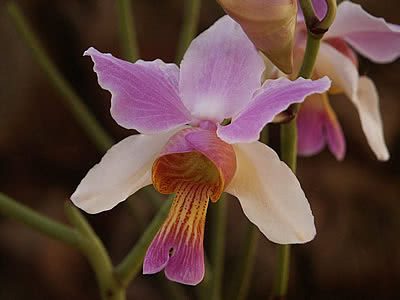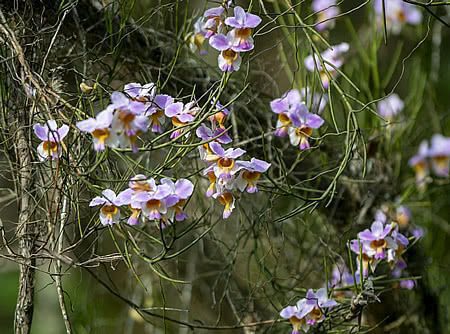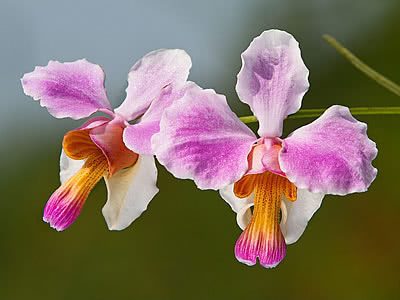The terete vanda (Papilionanthe teres) is a monopodial orchid that grows on tree branches (epiphyte) and has large, beautiful flowers reminiscent of butterflies. They are found in Southeast Asia, from eastern Nepal, Bhutan, and northeastern India, through Myanmar, Thailand, Laos, Vietnam, and southeastern China. They are also found in the Andaman and Nicobar Islands. The botanical name of this orchid has undergone several changes over time and is still controversial among orchid experts.
It was once classified within the genera Dendrobium, Aerides, and Vanda, until it was reclassified as Papilionanthe. The genus name comes from Latin, being a combination of “papilio” (butterfly) and “anthe” (flower). The species name also comes from the Latin teres, meaning circular, in reference to the plant’s cylindrical leaves. Interesting fact: The famous Vanda ‘Miss Joaquim’, the national flower of Singapore, is a hybrid between the terete vanda (Papilionanthe teres) and Papilionanthe hookeriana.

Terete vandas are characterized by their thin, long, and branched stems that grow quickly, easily reaching up to 6.56 feet (about 2 meters) in length and can produce several aerial offshoots. Their leaves are alternate, terete-type (long and cylindrical, like chive leaves), erect or curved, and about 5.9 inches (approximately 15 cm) in length. They produce aerial roots emerging from the nodes, usually at right angles to the leaves. The inflorescences also sprout from the nodes but in opposition to the leaves.
They can reach 11.8 inches (about 30 cm) in length and carry 3 to 6 flowers that open gradually from the base to the tip of the inflorescence. The flowers appear in spring, are fragrant, and have good durability and size, ranging from 2 to 4 inches (about 5 to 10 cm) in diameter. They are generally pale pink or pink in color, with an intensely pink labellum, a yellow center, and red striations. There is also a white-flowered form, P. teres f. candida. In addition to the terete vanda, there are other species of this genus in cultivation, including P. hookeriana, P. tricuspidata, and P. vandarum.

It should ideally be cultivated under full sun, but can be grown in partial shade in very hot or dry locations, which can cause burns on its leaves. This orchid prefers high light intensity, requiring between 50,000 to 60,000 lux. If using shade cloth, it should not exceed 30%. This species does not require a substrate for cultivation, but some growers like to place them in wood baskets containing pine bark, charcoal, and styrofoam. Nevertheless, it has a climbing behavior and will need to be trained on a support.
You can also grow it on a trunk, wire fence, or other structures. It thrives in tropical heat, high humidity, and intense ventilation. Supplement humidity by spraying the plant several times a day, preferably with well-diluted fertilizer in homeopathic doses, similar to orchids of the Vanda genus. Use only high-quality soluble fertilizers like Peter’s or PlantProd for terete vandas and supplement with biofertilizer. It does not tolerate drought or intense cold, and is susceptible to frost. Propagation is through the separation of segments containing roots and at least 7.9 inches (about 20 cm) in length.


